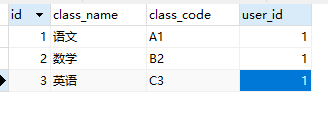今天在做项目的时候有一个地方需要用到嵌套查询,之前实现过类似的功能,但是在某些地方看到过类似的实现思路,自己试着实现了下发现行得通,于是就有了本文
首先是数据库,在这里我新建了两张表,一张用户表,一张课程表,具体如下
## 用户表
CREATE TABLE `test_user` (
`id` int NOT NULL AUTO_INCREMENT,
`username` varchar(255) CHARACTER SET utf8 COLLATE utf8_general_ci NULL DEFAULT NULL COMMENT '用户名',
`age` int NULL DEFAULT NULL COMMENT '年龄',
`gender` varchar(255) CHARACTER SET utf8 COLLATE utf8_general_ci NULL DEFAULT NULL COMMENT '性别',
PRIMARY KEY (`id`) USING BTREE
) ENGINE = InnoDB CHARACTER SET = utf8 COLLATE = utf8_general_ci ROW_FORMAT = Dynamic;
## 课程表
CREATE TABLE `test_class` (
`id` int NOT NULL AUTO_INCREMENT,
`class_name` varchar(255) CHARACTER SET utf8 COLLATE utf8_general_ci NULL DEFAULT NULL COMMENT '课程名',
`class_code` varchar(255) CHARACTER SET utf8 COLLATE utf8_general_ci NULL DEFAULT NULL COMMENT '课程编码',
`user_id` int NULL DEFAULT NULL COMMENT '用户id',
PRIMARY KEY (`id`) USING BTREE
) ENGINE = InnoDB CHARACTER SET = utf8 COLLATE = utf8_general_ci ROW_FORMAT = Dynamic;并往数据库里添加测试数据
INSERT INTO `test_user` VALUES (1, '小明', 16, '男');
INSERT INTO `test_class` VALUES (1, '语文', 'A1', 1);
INSERT INTO `test_class` VALUES (2, '数学', 'B2', 1);
INSERT INTO `test_class` VALUES (3, '英语', 'C3', 1);添加完之后数据库结构如下


然后去IDEA里编写相关类和接口,我这里使用的是Mybatis-Plus的代码生成器,不会用的小伙伴可以看一下我的这个文章
CSDN https://mp.csdn.net/mp_blog/creation/editor/120984912
https://mp.csdn.net/mp_blog/creation/editor/120984912
生成的代码在这里我就不做展示了,在实体类里添加一个对象
@Data
@EqualsAndHashCode(callSuper = false)
@TableName("test_user")
public class TestUser implements Serializable {
private static final long serialVersionUID = 1L;
@TableId(value = "id", type = IdType.AUTO)
private Integer id;
/**
* 用户名
*/
private String username;
/**
* 年龄
*/
private Integer age;
/**
* 性别
*/
private String gender;
/**
* 嵌套的class类对象
*/
private List<TestClass> classList;
}
接着分别去控制层、业务层、业务实现层以及数据层编写自己定义的代码
然后再去Mapper.xml里添加映射以及SQL的编写
<?xml version="1.0" encoding="UTF-8"?>
<!DOCTYPE mapper PUBLIC "-//mybatis.org//DTD Mapper 3.0//EN" "http://mybatis.org/dtd/mybatis-3-mapper.dtd">
<mapper namespace="com.example.test.mapper.TestUserMapper">
<!-- 通用查询映射结果 -->
<resultMap id="BaseResultMap" type="com.example.test.entity.TestUser">
<id column="id" property="id"/>
<result column="username" property="username"/>
<result column="age" property="age"/>
<result column="gender" property="gender"/>
</resultMap>
<!-- 嵌套查询映射结果 -->
<resultMap id="TestResultMap" type="com.example.test.entity.TestUser">
<id column="id" property="id"/>
<result column="username" property="username"/>
<result column="age" property="age"/>
<result column="gender" property="gender"/>
<!-- 对象映射 -->
<collection property="classList" ofType="com.example.test.entity.TestClass">
<result column="id" property="id"/>
<result column="class_name" property="className"/>
<result column="class_code" property="classCode"/>
<result column="user_id" property="userId"/>
</collection>
</resultMap>
<!-- 查询 -->
<select id="testQuery" resultMap="TestResultMap">
select u.*, c.*
from study.test_user u
inner join study.test_class c on c.user_id = u.id
</select>
</mapper>
调用一下方法看效果

执行成功,是我们想要的结果
以上
最后
以上就是专一钢铁侠最近收集整理的关于Mybatis嵌套查询 一对多查询的全部内容,更多相关Mybatis嵌套查询内容请搜索靠谱客的其他文章。
本图文内容来源于网友提供,作为学习参考使用,或来自网络收集整理,版权属于原作者所有。








发表评论 取消回复